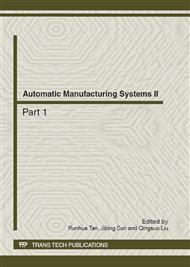[1]
N. Singh, "Systems Approach to Computer Integrated Design and Manufacturing," John Wiley and Sons, Inc. 1995.
Google Scholar
[2]
Peter Smith, "An introduction to knowledge Engineering," International Thomson Computer Press, 1996.
Google Scholar
[3]
F.C. Wang, et al., "A generic framework for the integration of mechanical and electrical CAD tools for concurrent design of consumer electronic products," Proceedings of the 1995 Design Engineering Technical Conferences, Vol. 1, pp.17-24.
DOI: 10.1115/detc1995-0003
Google Scholar
[4]
M. Yoshimura, H. Kondo, "Concurrent product design based simultaneous processing of design and manufacturing information by utility analysis," Proceedings of the 1995 Design Engineering Technical Conferences, Vol.1, pp.25-32.
DOI: 10.1115/detc1995-0004
Google Scholar
[5]
R. Xiao, J. Zhou, et al, "A new approach to intelligent design," Proceedings of the 1995 Design Engineering Technical Conferences, Vol.1, pp.105-110.
Google Scholar
[6]
S.K. Gupta, D.S. Nau, "Systematic approach to analyzing the manufacturability of machined parts," Computer-Aided Design, Vol.5,1995,pp.323-342.
DOI: 10.1016/0010-4485(95)96797-p
Google Scholar
[7]
N. Singh, S. Ding, et al, "A knowledge Engineering Framework for Rapid Design," Computers ind. Engng, Vol.33, 1997,pp.345-348.
Google Scholar
[8]
J. G. Cherng, X. Y. Shao, et al, "Feature-based Part Modeling and Process Planning for Rapid Response Manufacturing," Computers ind. Engng, Vol.34,1998,pp.515-530.
DOI: 10.1016/s0360-8352(97)00138-1
Google Scholar
[9]
J. S. Colton, "An Intelligent Design for Manufacture Systems, Concurrent Engineering: Automation, Tools and Techniques," Wiley, New York, 1992,pp.153-176.
Google Scholar
[10]
S. K. Gupta, D. S. Nau, W. C. Regli, et al, "A Methodology for Systematic Generation and Evaluation of Alternative Operation Plans, Advances in Features Based Manufacture," Elsevier, New York, 1994,pp.161-184.
DOI: 10.1016/b978-0-444-81600-9.50013-4
Google Scholar
[11]
S. K. Ong, A. Y. C. Nee, "Manufacturability evaluation and generation of Re-design suggestion for machined parts," The Int. J. Manuf. Sci. Prod., Vol.1,1998,pp.87-105.
DOI: 10.1515/ijmsp.1998.1.2.87
Google Scholar
[12]
S. K. Ong, M. J. Sun, A. Y. C. Nee, "A fuzzy set AHP-based DFM tool for rotational parts," J. Materials Processing Technology, Vol.138,2003,pp.223-230.
DOI: 10.1016/s0924-0136(03)00076-1
Google Scholar
[13]
J. Shang, T. Sueyoshi, "A unified framework for the selection of a Flexible Manufacturing System," European Journal of Operational Research, vol.85, 1995, pp.297-315.
DOI: 10.1016/0377-2217(94)00041-a
Google Scholar


